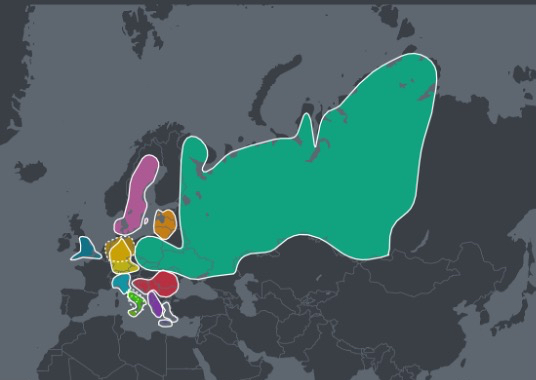Good Thing We Don’t Essentialize Identity
 My ethnic background keeps changing. A few years ago, I deposited that bit of saliva into a test tube and mailed it to the processing company. My DNA mix was pretty much what I expected: about half aligned with people who also took the test and live in Southern Italy, with the rest from Germany, Bohemia, and other nations near the eastern edge of Europe.
My ethnic background keeps changing. A few years ago, I deposited that bit of saliva into a test tube and mailed it to the processing company. My DNA mix was pretty much what I expected: about half aligned with people who also took the test and live in Southern Italy, with the rest from Germany, Bohemia, and other nations near the eastern edge of Europe.
However, as more people take the test and results are included in the database, I’ve become less Italian and more Eastern European—in terms of ancestry. This does not mean I’m going to eat more sauerbraten and less eggplant parm, but the shifting DNA results do bring the constructed nature of my identity to my foreground attention.
Very interesting, especially since my family-of-origin played up the Italian side more than the Bohemian-German side (Dad’s parents were both Italian immigrants; we don’t know when my mom’s ancestors immigrated or exactly from where). My adult children, whose genetic heritage from Italy is much lower than mine, nevertheless lean into the Italian fraction with gusto.
Our teen daughter, adopted from Guatemala, presents a really interesting picture. Predominantly Mayan, yes, followed by Spanish, and then a mosaic of ancestors from centuries ago from a few African nations and even Iran/Persia. Oh, the histories of conquest, invasion, and ethnic mixing represented in her DNA. And, despite our best attempts to keep her connected to Guatemalan culture, her musical and culinary loves are K-Pop and Korean and Japanese foods. Her choices.
Good thing that in America we don’t essentialize identity, don’t select elements from culture (things that could be other than what they are), raise them to the level of “natural,” and then construct power arrangements based on “nature.”
I’m saying this, of course, with some sarcasm. We Americans have constructed deeply divided identities as if the dividing lines were revealed by God.
Identity is always a construction. There is hardly anything “natural” about it. Identity is self-selected for those with power and imposed on others by those in power.
The so-called “one drop” rule and “blood quantum” used to determine “race” reflected the white supremacist-bathed science of the day. There is only one race. That said, the term “race” is not going to disappear or become irrelevant anytime soon. But one can hope a change in social equity and in culture might someday bring an end to a racist understanding of race.
About 10 percent of Americans now identity as mixed-race. I suspect that, if everyone got their DNA tested, that number would be several times higher.
Over 40 percent of American adults have switched religious identities at least once in their lives.
The quests for pure doctrine and exacting boundaries around religious communities are doomed to fail. Oh, some religious communities construct mythic stories either of a pure origin or the possibility of a pure future. But, in reality, religions over time have influenced each other, have borrowed and adapted from each other, often for the better. There would have been no Reformation in Christianity or Renaissance in Europe without all the contributions of Islamic scholars who kept Greek learning alive during the West’s Middle Ages. There is no Christianity without Judaism. One could not comprehend Buddhism without Hinduism.
Sexualities have always been multiple and genders fluid. But enough social space has been made, at least for the time being, to express them.
Party politics in the U.S. has always been identity politics. For most of our history, at the state and federal levels, white, male, and wealthy were the three identities that mattered most. That fact is demonstrated amply by whose portraits line the walls of capitols. Today’s identity politics are much more complicated. This is not only because other categories of persons are organized and using their power. It is also because identities are swirling, not quite at a kaleidoscopic complexity but getting there.
There is nothing “natural” or “inevitable” about the identity polarization in the nation today. The mega-identities of Red and Blue are fictions. Unnecessary fictions. Dangerous fictions. Unsustainable fictions.
I wish there were the equivalent of DNA tests for religious, philosophical, moral, gender, sexual, class, and political identities. We would surely be surprised by the complexity, the ambiguities, and the multiplicity that each of us is and each of our identity groups are. The results of such tests might lead us to be more humble, more curious, more generous, and feeling more connected to those we thought were not like us—but, in reality, are.
Dr. Gary Peluso-Verdend is president emeritus at Phillips Theological Seminary and is the executive director of the seminary’s Center for Religion in Public Life. The opinions expressed in this blog are those of the author. Learn more about the Center’s work here and about Gary here.


Comments are closed.